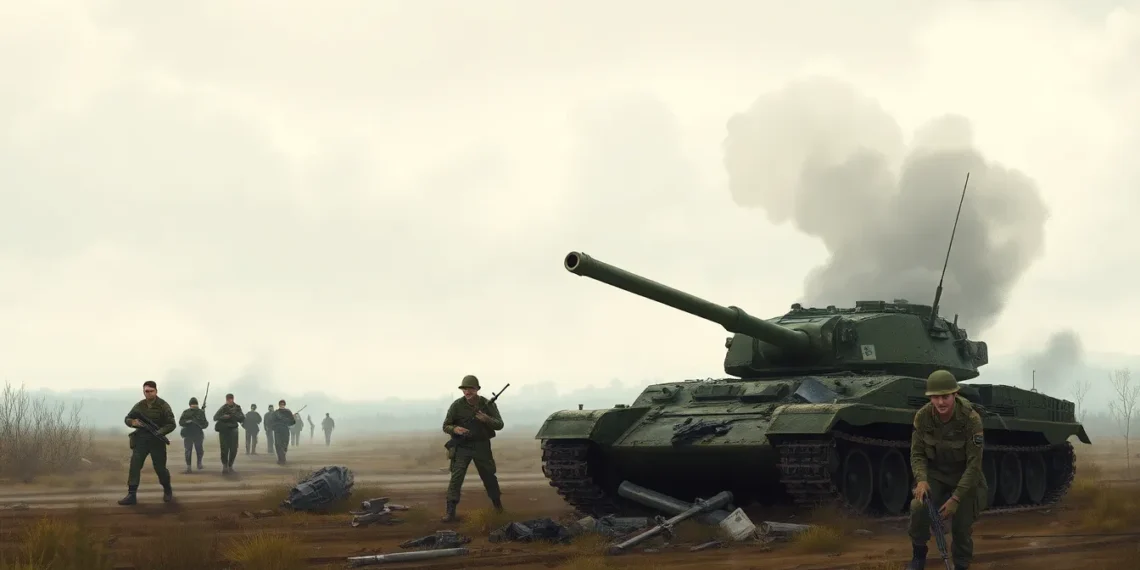In the ongoing saga of the Ukraine conflict, one of the most eyebrow-raising chapters is the tale of Russian equipment losses. Picture this: a military force with an arsenal that could make a sci-fi movie jealous, yet somehow, it finds itself losing more tanks than a toddler loses toys in a messy playroom. It’s a situation that’s both alarming and oddly amusing, showcasing the unpredictable nature of modern warfare.
As the dust settles on the battlegrounds, analysts are crunching numbers and shaking their heads in disbelief. From armored vehicles to aircraft, the inventory of misfortune seems to grow daily. Dive into this article to explore the staggering statistics and the implications of these losses, all while chuckling at the absurdity of it all. Who knew war could have such a darkly comedic twist?
Overview of Russian Equipment Losses in Ukraine So Far
Russian forces face significant equipment losses in the ongoing conflict with Ukraine. Reports indicate that over 1,600 tanks have been destroyed since the invasion began in February 2022. Such a high destruction rate exposes vulnerabilities in Russia’s military strategy and logistics.
In addition to tanks, Russia has lost thousands of armored personnel carriers, artillery systems, and drones. The current estimates show that approximately 5,500 vehicles have been lost, including a variety of military hardware. These figures highlight the overall impact on the Russian military capabilities.
Analysts suggest that the rapid depletion of resources stems from both effective Ukrainian tactics and external support. Western nations supply Ukraine with weaponry and intelligence, enabling it to target Russian equipment more effectively. Such support plays a crucial role in leveling the playing field.
Data indicates that Russian personnel are also grappling with operational challenges and morale issues. High casualty rates among soldiers contribute to the difficulties in maintaining and deploying military resources. The ongoing attrition might lead to further equipment losses as the conflict continues.
Overall, the significant number of lost assets demonstrates the challenges in the current battlefield environment. Analysts continue to monitor the situation, providing updates on the evolving dynamics of military engagements and equipment losses in Ukraine.
Ground Forces Equipment Losses
Russia’s ground forces are experiencing significant equipment losses in Ukraine as the conflict progresses. Analysts continue to evaluate these losses, revealing impacts on military effectiveness and strategy.
Armored Vehicles
Over 1,600 tanks have been destroyed, indicating severe vulnerabilities in the armored vehicle fleet. Many of the lost vehicles include various models, like the T-72 and T-80, which are critical to Russian ground operations. They’ve faced effective Ukrainian tactics, utilizing precision strikes and advanced weaponry, contributing to these significant losses. Approximately 5,000 additional armored vehicles, such as infantry fighting vehicles and armored personnel carriers, are no longer operational, further diminishing Russia’s combat capabilities. The depletion of these assets directly affects troop movement and firepower on the battlefield.
Artillery Systems
Losses extend to artillery systems, with estimates suggesting around 1,000 pieces of equipment, including howitzers and rocket systems, destroyed. High- and low-caliber artillery, particularly the 2S19 Msta and BM-21 Grad systems, have become prime targets due to their critical role in supporting ground troops. Effective Ukrainian counter-battery tactics and improved targeting intelligence contribute to the destruction of these assets. Russian artillery capabilities are hindered, leading to decreased effectiveness in fire support. Such losses impact Russia’s ability to sustain prolonged engagements and maintain pressure on Ukrainian positions.
Air Force Equipment Losses
Russian air force equipment losses in Ukraine demonstrate significant operational challenges. Fighter jets and helicopters represent critical assets, both of which have sustained substantial damage since the conflict began.
Fighter Jets
Over 80 Russian fighter jets have been destroyed during the ongoing conflict, including advanced models like the Su-30 and Su-34. Each loss impacts Russia’s air superiority capabilities, forcing the military to adjust its aerial tactics. Ukrainian forces employ advanced missile systems and air defense technology, making it difficult for Russian aircraft to operate safely. Drones, often used for reconnaissance and targeting, have also contributed to the destruction of these jets. Analysts observe that the loss of air assets limits Russian ground support and enables improved counter-offensives by Ukrainian forces.
Helicopters
Helicopter losses exceed 100 units, significantly affecting troop transportation and combat support. Russian models such as the Mi-24 and Mi-8 account for many of these losses. Effective Ukrainian anti-air tactics, including shoulder-fired missiles and guided munitions, target these helicopters during operations. They struggle to maintain operational effectiveness when faced with increased risks. The inability to maintain aerial mobility compromises Russia’s ability to reinforce positions and respond to threats, contributing to broader challenges in their military strategy.
Naval Equipment Losses
Significant naval equipment losses have occurred within the Russian fleet since the conflict began. These losses underscore vulnerabilities in maritime strategy and operational execution.
Warships
Russia has lost multiple warships, with the destruction of at least one guided-missile cruiser and several smaller vessels. Analysis indicates that these ships faced challenges from Ukrainian naval forces and coastal defense systems. The Moskva, once a flagship, stands as a notable loss, impacting Russia’s naval presence in the Black Sea. Effective Ukrainian strikes on naval assets cripple operational capabilities and hinder Russia’s ability to project power in maritime domains. Surveillance reports suggest that continued Ukrainian advancements pose risks to remaining ships, prompting operational realignments.
Submarines
Submarine losses also significantly affect Russian naval operations. Reports indicate potential damage to at least two submarines during the conflict, undermining their stealth and strategic deterrence capabilities. Losses in this area limit Russia’s ability to conduct underwater warfare and gather intelligence. Ukrainian forces, through improved surveillance and targeting methods, contribute to these challenges, raising concerns about the effectiveness of Russia’s submerged fleet. Analysts emphasize that diminished submarine operations escalate vulnerabilities, further complicating Russia’s overall military strategy at sea.
Impact on Military Capability
Russian equipment losses have significantly diminished its military capability. Over 1,600 tanks, including the T-72 and T-80 models, are no longer operational. These losses directly affect troop movement and firepower on the ground.
The depletion of approximately 5,500 vehicles, such as armored personnel carriers and artillery systems, further complicates military operations. Approximately 1,000 artillery systems, including howitzers, have fallen, challenging Russia’s ability to sustain prolonged engagements. Effective Ukrainian counter-battery tactics have played a role in this reduction, showcasing strategic advantages in targeting Russian positions.
Air superiority suffers due to the destruction of over 80 fighter jets, including the advanced Su-30 and Su-34. Helicopter losses exceeding 100 units limit troop transportation and combat support capabilities. Compromised aerial mobility affects the response to threats and reinforcement of positions.
Naval operations also face hurdles. The loss of multiple warships, including the guided-missile cruiser Moskva, impacts Russia’s naval presence in the Black Sea. Effective Ukrainian strikes have crippled naval capabilities, hindering power projection at sea. Damage to at least two submarines further undermines stealth and strategic deterrence in underwater warfare.
The interplay between these significant losses escalates vulnerabilities in Russia’s military strategy. Analysts continuously monitor the evolving dynamics of military engagements and the ongoing impact on Russian capabilities in Ukraine.
Reveal Critical Weaknesses
The staggering losses of Russian equipment in Ukraine reveal critical weaknesses in military strategy and execution. The ongoing conflict continues to expose vulnerabilities that challenge Russia’s operational effectiveness. As equipment losses mount, the implications for troop morale and overall combat readiness become increasingly significant.
The data reflects a shifting battlefield landscape where Ukrainian tactics and international support play pivotal roles. This evolving situation not only impacts Russia’s immediate military capabilities but also raises questions about its long-term strategic outlook. Observers will undoubtedly keep a close eye on how these losses influence the course of the conflict moving forward.







